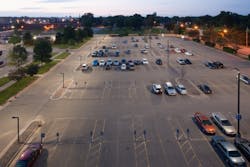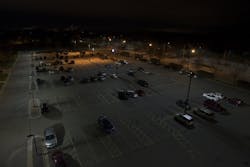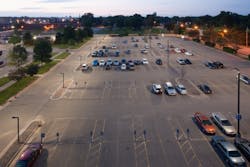The ThedaCare Health System located in Wisconsin has been a leader in sustainability initiatives and late last year also recognized that outdoor area lighting at a number of its facilities were in need of an upgrade -- both due to excessive maintenance requirements and uneven light quality. The organization has performed a thorough evaluation of LED lighting and upgraded two of its facilities to solid-state lighting (SSL). The healthcare provider projects $40,000 annually in electrical and maintenance savings based on its first outdoor SSL projects.
BEFORE
AFTER
The ThedaCare outdoor areas and parking lots have been lit by a mix of metal-halide (MH) and high-pressure sodium (HPS) lighting with the result being non-uniform light levels and disparate color temperatures as the top photo illustrates. The light quality caused concerns across the organization. "Security staff was very concerned about light levels for safety," said Steve Jencks, construction project manager for ThedaCare. "They wanted to make sure the new lighting would provide better visibility both on-site, as well as through security cameras."
And of course energy conservation was also a concern. "From my perspective, healthcare organizations must lead the way in reducing fossil fuels," said ThedaCare sustainability leader Paul Linzmeyer. "The first thing we are working on is to reduce demand. If we reduce demand, that is less pollution going into the environment. While some of sustainability work is about saving money, it is really about reducing the amount of greenhouse gases going into the environment. Healthcare's first obligation should be to do no harm to our environment -- for health and safety reasons."
The organization turned its attention to two of more than 30 hospitals and facilities in Wisconsin. The Theda Clark and Appleton Medical Center (AMC) have large parking lots measuring 861,000 and 916,000 ft2, respectively. Moreover, the Theda Clark facility is adjacent to a residential area and had generated complaints about light pollution.
ThedaCare partnered with Elan Lighting to evaluate the impact that a lighting retrofit might have o the operational costs. The analysis revealed that lighting would deliver relatively quick return on investment (ROI) and identified LED lighting as the most efficient option. "LEDs are the best solution right now for lighting in general," said Mark Zelten, application and sales manager at Elan Lighting. "It is certainly going to be the light source for decades to come. LED was the way to go for the Theda Clark and AMC campuses, and we wanted to maximize their investment."
Still, the organization wanted assurance that the SSL option would deliver on its quality goals. ThedaCare and Elan Lighting worked together to select the Acuity D-Series LED luminaires from the Lithonia Lighting brand. The project primarily relied on the area lights for parking lights although it also includes lesser numbers of D-Series wall packs, flood lights, and parking garage luminaires.
The first two projects will deliver numerous benefits. The lumen output and uniform beam of the LED products allowed the organization to reduce the total number of luminaires. For instance, at the Theda Clark facility, 60 LED luminaires replaced 84 legacy fixtures.
Still, the lighting is much improved. "You can see a vast difference between newly lit lots with a more even distribution, and the yellow from the old lights that cast an ugly glow," explained Jencks. "When we have foggy, frosty mornings, you can really tell the improvement of the LED."
The light-spill problem was also mitigated. "The new lighting in the parking ramp at the AMC campus looks very nice at night," said Jamie Coenen, a ThedaCare security officer at AMC. "The new lighting is not too bright for the neighboring houses and makes it so much easier to see inside the ramp. The lights are mounted high enough that it does not affect your sight or disperse light outside of the ramp."
In the Theda Clark project alone, the healthcare provider projects that its will save $89,500 in energy costs and $58,600 in maintenance costs over ten years. Meanwhile, the LED lighting is projected for 10,000 hours of life. The projected ROI is five years.







